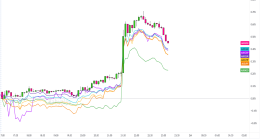
October 3, 2020 6 min read
Opinions expressed by Entrepreneur contributors are their own.
Big data as a concept is thrown around a lot. It’s often used as a buzzword to sound tech-savvy and on the ball — but how much do you really know about it? In truth, it’s been around for decades. Businesses have been analyzing their customers’ actions and behaviors and using it to inform their business decisions for a long time; it’s the marker of a strong businessperson. The difference today is that we now have the tools and technology to gather and analyze larger amounts of data faster. Enter big data.
Related: The Pivotal Role of Big Data in Ecommerce
You don’t have to be a tech genius or a data scientist to make big data work for you and your business. Here are seven areas where you can use big data to streamline and optimize what you already have, with key examples and actionable tips to get you started.
1. Website design
To prove that big data is not only for the scientists of the world, let’s start with a more creative example. A well-designed website shouldn’t only look good, it should be part of a subtle conversation going on between you and your customers and leads.
One way to gather useful big data from your website is through heat maps. You can see exactly where the eyes and cursors of visitors to your site spent the most time. If these heat spots aren’t on your CTA button, contact form, or wherever else you most want them to go, you know what needs to be changed. You can achieve similar results with traffic analysis — looking at page views, unique visitors, visit duration and more. Many traffic analysis tools will also let you compare to your competitors’ sites to get a bigger picture of the general landscape.
2. Campaign timing
Have you ever put together a five-star marketing campaign that ticks all of your customer persona boxes, looks great and has a punchy CTA — only to see it flop? The greatest campaigns in the world will get you nowhere if you don’t publish them at the right time.
Whether you’re publishing on social media, email or any other digital platform, there are tools (like Growbots for email or Sprout Social for social media) that will gather data for you about when your audience is most active, when they are most prone to engaging and ultimately when the best time to reach them is. With big data, you don’t have to take a stab in the dark about when to launch a winning campaign.
3. Conversion optimization
There are a lot of variables when it comes to on-site content. While that may seem daunting to some, that really just means that there’s a lot of room for optimization so that your business can do even better than it is now. From headline copy to page color scheme, it can all be tweaked and improved to gather the highest amount of conversions possible.
Big data analytics can help us to understand how leads travel through our sales funnels, where they might get lost and at what point many prospective customers drop off. Data-driven optimization is the fastest and most efficient way to get it right. Even while experimenting, be sure to gather as much data as possible and analyze it in bulk for the most accurate and informative results.
Related: 5 Things That Cause Reasonable Consumers to Abandon Their Shopping Carts
4. Personalized communication
No matter what your business is, at the end of the day it will come down to people making a decision. Big data might seem like a huge and faceless tool, but it can also be used to add more personality and individuality to your marketing and customer interaction.
The fashion brand, H&M, used big data to do exactly that when they integrated it with their chatbot. As it offered options to prospective customers and asked them if they liked the product choice, it learned more and more about what clothing options they liked. Along the same vein, for marketers to make personalized decisions that will have a real impact on leads and customers, we need to learn about them first. Big data is one effective way to do so.
5. Customer retention
A good business person knows how to attract and win clients. A great business person knows how to keep loyal customers. Once again, big data can take the heavy lifting out of this process.
Checking in with your existing customers through quick surveys and polls is one way to be continually staying in touch with how they perceive your company and what they think of your products or services. It’s anywhere between five to 25 times more expensive to find a new customer than to retain an existing one, depending on your industry. Use big data to regularly make sure that you are doing exactly what your existing customers are expecting of you.
6. Informing risk management
Risk is a fact of life for any business. Wouldn’t it be great if we could find a way to make smarter strategic decisions with key data to back up our more risky ventures? With big data, that could be a reality.
UOB Bank in Singapore did it. As a financial institution, making a misstep in risk assessment and management could be catastrophic. The bank used big data to develop a risk management system that cut down their risk analysis time from 18 hours to just a few minutes. Being able to carry out extensive risk analysis in real-time was a game-changer.
Of course, not every business has the ability or the resources to create their own risk management solution from scratch but there are tools out there that help businesses accurately quantify the risks they take on a daily basis, shedding light on one of the trickiest parts of business decision-making.
Related: Cybersecurity Practices That Protect Your Small Business
7. Smart business growth and innovation
Think about the most successful businesses in the world — Amazon, Apple and Microsoft, just to name a few. They didn’t get to where they are today by sticking to their first idea and running with it. They diversified, innovated and kept up with other demands from their customers. Often, it was big data that showed them the way.
Let’s look at Amazon’s recent venture, Amazon Fresh. To launch their whole foods service, Amazon focused on big data analytics to not just understand how customers buy groceries, but also how suppliers interact with grocers. Big data helped them understand the whole supply chain and find a solution that streamlined every aspect of it, thereby providing an innovative and helpful service.
For any business, big data can illuminate the bigger picture when you’re looking to expand, introduce a new product, or evaluate your current services. When it comes to business growth, use big data to do it smarter.
loading…
This article is from Entrepreneur.com








